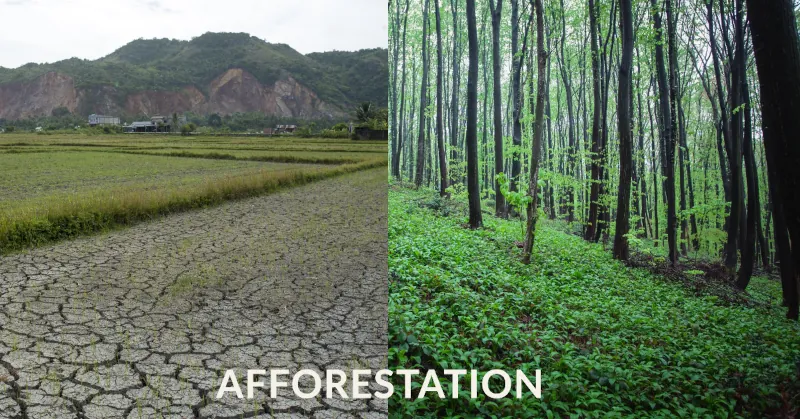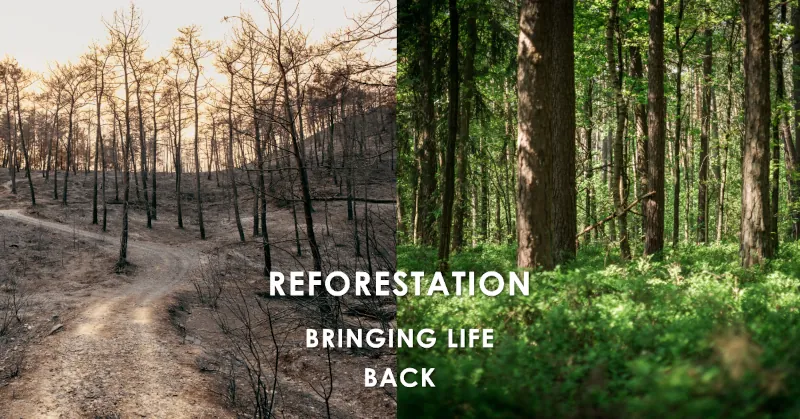There are two distinct ways to increase forest cover: afforestation and reforestation.
Both practices play a crucial role in environmental conservation and promote the well-being of our ecosystems.
While they share the common goal of expanding forests, afforestation and reforestation differ significantly in their approaches and objectives. Understanding the distinction between these two methods is crucial for effective forest management, ecological restoration, and build a more sustainable future for our planet.
What is Afforestation?
Afforestation refers to the process of establishing a forest on land that has not been forested for a prolonged period or has never been forested. It involves planting trees and creating a new forest ecosystem from scratch. Afforestation projects target areas where the land has been degraded, desertified, or converted for agricultural or urban use.

The primary objectives of afforestation include:
- Carbon sequestration: Trees absorb carbon dioxide from the atmosphere, contributing to a cleaner atmosphere and healthier environment.
- Soil conservation: Newly planted trees help prevent soil erosion and improve soil quality.
- Habitat creation: Afforestation can create new habitats for various plant and animal species, promoting biodiversity.
- Economic benefits: Afforestation can provide economic opportunities through the production of timber, fuel, and other forest products.
What is Reforestation?
Reforestation, on the other hand, is the process of replanting trees on land that has previously been forested but has been cleared or degraded. It aims to restore or regenerate a forest ecosystem that has been lost or damaged due to factors such as deforestation, wildfires, or natural disasters.

The primary objectives of reforestation include:
- Restoring ecological balance: Reforestation helps re-establish the natural ecosystem and restore the ecological functions of the forest.
- Combating deforestation: Reforestation counters the effects of deforestation by replenishing lost forest cover.
- Habitat restoration: Reforestation helps recreate habitats for native plant and animal species, supporting biodiversity conservation.
- Economic and social benefits: Reforestation can provide economic opportunities through sustainable forestry practices and enhance the well-being of local communities.
Key Differences between Afforestation and Reforestation:
- Land type: Afforestation is carried out on land that has not been forested for a long time or has never been forested. Meanwhile, reforestation is done on land that was previously forested. Land chosen for afforestation projects can also vary depending on factors like climate and rainfall.
- Ecosystem: Afforestation creates a new forest ecosystem, while reforestation aims to restore a previously existing ecosystem. Reforestation efforts also aim to restore the ecological functions of the forest, such as water filtration and nutrient cycling.
- Species selection: In afforestation, the choice of tree species may be more flexible, depending on the desired outcomes. Reforestation, on the other hand, often focuses on replanting native species to recreate the original forest composition. Afforestation projects may also consider fast-growing species for initial establishment, followed by planting native trees later.
- Challenges: Afforestation may face challenges such as poor soil conditions and lack of existing infrastructure, while reforestation may encounter obstacles like invasive species and degraded soil. Afforestation projects may also face challenges from grazing animals or competition from weeds.
Conclusion
While both afforestation and reforestation contribute to increasing forest cover and combating environmental challenges, they differ in their approaches and objectives.
Afforestation creates new forests, while reforestation restores previously forested areas.
Overall, understanding these differences is crucial for implementing effective forest management strategies and achieving sustainable environmental goals.
Additional Resources
If you’re interested in learning more about afforestation, reforestation, and sustainable forestry practices, check out the following resources:
- United Nations Forum on Forests – The UN’s dedicated platform for promoting sustainable forest management and raising awareness about the importance of forests for sustainable development.
- World Resources Institute’s Forests Program – Provides research, data, and resources on forest conservation, restoration, and sustainable management.
- The Nature Conservancy’s Reforestation Initiatives – Explore the organization’s various reforestation projects and initiatives aimed at restoring and protecting forests worldwide.
- FAO Forestry – The Food and Agriculture Organization of the United Nations’ dedicated website for forestry-related information, publications, and resources.
- IUCN Forest Conservation Programme – The International Union for Conservation of Nature’s program focused on promoting sustainable forest management and conservation.
- Ecosia – A search engine that uses its profits to plant trees and support reforestation efforts globally.
- Plant-for-the-Planet – A non-profit organization dedicated to raising awareness about climate change and empowering children to plant trees.
These resources provide a wealth of information, research, and opportunities to get involved in afforestation, reforestation, and sustainable forestry initiatives. Therefore, explore them to deepen your understanding and find ways to contribute to the preservation and restoration of our planet’s forests.

